Creating a new signature
As stated before, creating a simple signature in Outlook isn’t a hard task. Most likely you already have one. To create a signature and set options for it you go to;- Outlook 2007 and previous
Tools -> Options -> tab Mail Format -> button: Signatures… - Outlook 2010 and Outlook 2013
File-> Options-> section Mail-> button Signatures…
New signature wizard in Outlook 2003 and previous
When you create a new signature in Outlook 2003 or previous, you’ll be presented with the following Wizard to create a new signature.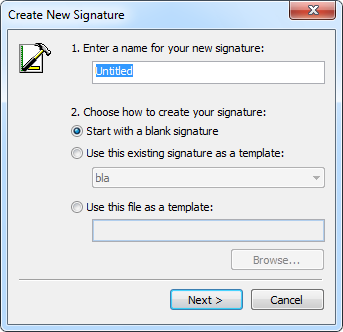
Create New Signature Wizard in Outlook 2003 and previous.
When you’ve specified a name you’ve got 3 options;
- Start with a blank signature; this will start the editor with a blank screen
- Use this existing signature as a template; this will start the editor with a copy of the selected signature (this option is only available when you already have at least one signature)
- Use this file as a template; this will let you choose a htm or html-file you’ve already created with e.g. FrontPage or Word. Outlook will copy the content of the file into the editor.
Note:Even though using
existing signatures or files as a template is no longer possible in
Outlook 2007 and 2010, you can still achieve this by copying existing
signatures to the Signatures folder.
Using the Signature Editor
While the Signature Editor got a major visual overhaul in Outlook 2007, the available functions are still similar to the Signature Editor which can be found in Outlook 2003 and previous.Using different Fonts
Modifying the font setting is probably pretty much self-explanatory. The only real thing to note is that you shouldn’t use too exotic fonts for your signature. This is because in order for the receiver to see your signature as you intended, that font also needs to be installed on the machine of the recipient. If that font is not installed, then the receiver would see that text in a different font, the wrong characters or even just placeholder characters (empty square boxes).
Tip!
In general, it is pretty safe to use the Windings font if you want to use characters such as * 8 ( to represent information for things such as e-mail address, web address and phone number.
However, use it with caution as recipients working on non-Windows computers might not have this font installed. It is also needed to edit your Plain Text signature as otherwise you’ll only see the characters * 8 (
In general, it is pretty safe to use the Windings font if you want to use characters such as * 8 ( to represent information for things such as e-mail address, web address and phone number.
However, use it with caution as recipients working on non-Windows computers might not have this font installed. It is also needed to edit your Plain Text signature as otherwise you’ll only see the characters * 8 (
Adding a picture/logo
Adding a picture or a logo to a signature is quite easy but there are a few tricks to it to do it properly.First, you must prepare the picture or logo that you want to use; edit it in a picture editing program so that it has exactly the dimensions as how you want to use it in your signature.
Second, save it in a format that makes the file size as small as possible. The jpg-format works well for pictures, the png-format works well for detailed graphics and the gif-format works well for simple graphics. You should aim for an end-result not larger than 10KB.
Third, decide whether you want to embed the image into each and every message that you send or to locate it on the web and have it load from there. In case of the last, you must also set the option for Outlook to send a link instead of a copy for linked images.
Once that you have prepared your image, you can insert it in the following way;
- Outlook 2003 and previous
In the signature editor, right click on the place where you image should come and choose; Insert Image… - Outlook 2007, Outlook 2010 and Outlook 2013
In the signature editor, press the image icon (between the Business Card icon and the Hyperlink icon)
To maintain the URL reference to the picture in Outlook 2007, Outlook 2010 and Outlook 2013, you must also use; Insert-> Link to File

Link to File will load image from the Internet.
Adding hyperlinks
While you could add a link to a website by simply typing it in full, it will probably look nicer when you type for instance the name of your company and make that link to your corporate website or have the word, “Facebook” or “Twitter” link to your profile page.To add such a link, first type and then select the word that you want to make clickable. If you are using Outlook 2007 or Outlook 2010, you can add the link by pressing the globe icon on the right. If you are using Outlook 2003 or previous, right click on the selected word and choose “Edit Hyperlink…”.
You can even combine this with inserting a picture or logo and then make this image clickable via a hyperlink.

Link images to social pages in your signature.
Note:If you insert
clickable text in your signature, only your text will be shown in the
Plain Text signature and the link itself will be gone.
Adding a business card
Another option is to include a business card (vCard) to your signature. A vCard is a vcf-file that contains contact information. The Signature editor will let you easily create a vcf-file based on a contact you’ve stored in you’re address book. People receiving the vcf-file can now easily add all you’re contact information in their favorite address book as the vcf-format is supported by many contact management programs.In Outlook 2007, Outlook 2010 and Outlook 2013, adding a business card will also add an image representation of your business card to your signature. You can edit this image by opening your contact from the Contacts folder and press the Business Card button in the Options section. If you remove the vCard image in the signature editor, it will also remove the vcf-file from your signature.
Tips!
If you want to create a signature with a vcf-file but do not want to have an image of it added to your signature design, then see this Quick Tip; Add Business Card to signature without image
If you want to create a signature with just the image of your business card and not attach a vcf-file see the Quick Tip; Add Business Card image to signature without vcf-file
You can also type something like “Get my vCard” in your signature and link it to a vcf-file you uploaded to the Internet to let people easily add your contact details without needing to add a vcf-attachment to your e-mails.
In Outlook 2013, if you have the People view selected for your Contacts folder, you won’t be able to modify the Business Card or Contact Image. To do this, you must open the full contact editing form first.
If you want to create a signature with a vcf-file but do not want to have an image of it added to your signature design, then see this Quick Tip; Add Business Card to signature without image
If you want to create a signature with just the image of your business card and not attach a vcf-file see the Quick Tip; Add Business Card image to signature without vcf-file
You can also type something like “Get my vCard” in your signature and link it to a vcf-file you uploaded to the Internet to let people easily add your contact details without needing to add a vcf-attachment to your e-mails.
In Outlook 2013, if you have the People view selected for your Contacts folder, you won’t be able to modify the Business Card or Contact Image. To do this, you must open the full contact editing form first.
Advanced Edit
If you are using Outlook 2003 or previous, you’ll also see a button called “Advanced Edit…”. When you press this button you’ll open your default HTML-editor to create your signature in, instead from within the built-in Signature editor.The default HTML-editor has nothing to do with having Word or Outlook set as your e-mail editor. The default HTML-editor is an option which you can set in Windows;
- From the Windows Start Menu select Control Panel.
- Open Internet Options.
(in Windows Vista, Windows 7 and Windows 8, you can can find this under the Network and Internet category) - Select the Programs tab.
- You can use the drop down list to select from the available HTML-editors installed on your computer.
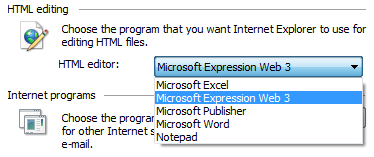
The Advanced Editor can be set via Internet Options.
Assigning default signatures
To have your signature always be added to your messages, you can set it as the default. When using Outlook 2003 or previous, you can do this directly on the Mail Format tab of the Options dialog. In Outlook 2007, Outlook 2010 and Outlook 2013, you can do this in the Signature editor itself. You can specify a default signature for new e-mails and the same or another signature on replies and forwards.Starting with Outlook 2003 (with Word as the e-mail editor), you can even specify different default signatures on an account basis. This means that when you have multiple e-mail accounts and you were to change your sending account when composing a message, your signature would change automatically as well.
Note:
For the automatic signature feature to work, you must have a default signature assigned to each account. This can even be an empty signature or a signature with just a space, a full stop or some dashes (–) in it.
For the automatic signature feature to work, you must have a default signature assigned to each account. This can even be an empty signature or a signature with just a space, a full stop or some dashes (–) in it.
Tip!With VBOffice SAM,
you can also let Outlook automatically select the correct signature for
you based on the folder that you are in, which category has been
assigned to a message or who you are sending your message to.
Inserting and changing signatures manually
If you do not like to have a default signature set, you can still add a signature manually when you are composing your message.Outlook 2003 and previous
With Outlook 2003 and previous and having Outlook set as the e-mail editor, you can press the signature button or use Insert-> Signature to insert a signature. It will automatically expand when you have more than one signature configured.When you use Outlook 2003 or previous and have set Word as the e-mail editor, you must have a default signature configured or you won’t be able to select another signature while composing the e-mail. To select another signature, right click on the left side of the signature and a list of available signatures will pop-up.
Tip!
If you don’t want a default signature, you can easily workaround this by configuring an empty signature (just containing spaces or Enters or a single dot) as the default signature. This will still enable the right click menu so you can choose a signature when you want to.
If you don’t want a default signature, you can easily workaround this by configuring an empty signature (just containing spaces or Enters or a single dot) as the default signature. This will still enable the right click menu so you can choose a signature when you want to.
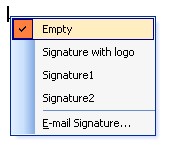
Manually change the signature via a right click.
Outlook 2007, Outlook 2010 and Outlook 2013
In Outlook 2007, Outlook 2010 and Outlook 2013, it is no longer needed to have a default signature configured in order to make the manual or automatic signature switching work (it is for automatic switching though!).To manually insert a signature into your message, you can use the Signature button in the Include section of the Message tab. To manually change a signature, you can also use this button or right click in the left margin of the signature area and select your signature from the pop-up dialog.
Note:
If changing the signature removes (part of) your messages as well, you’ve been typing into the signature area. When that happens, undo the signature change immediately (CTRL+Z), select the text portion of your message and press CTRL+X (to cut to Clipboard). After this, change your signature and paste the text back into your message (CTRL+V).
If changing the signature removes (part of) your messages as well, you’ve been typing into the signature area. When that happens, undo the signature change immediately (CTRL+Z), select the text portion of your message and press CTRL+X (to cut to Clipboard). After this, change your signature and paste the text back into your message (CTRL+V).
Backing up your signatures
After you’ve carefully created your signatures, you probably want to back them up or migrate them to another or new computer. The process is very simple; copy all the files from the Signatures folder to your backup location. To restore them, you can copy them back to the Signatures folder.By default you can find the Signatures folder in the following location;
- Windows XP
C:\Documents and Settings\%username%\Application Data\Microsoft\Signatures - Windows 8, Windows 7 and Windows Vista
C:\Users\%username%\AppData\Roaming\Microsoft\Signatures
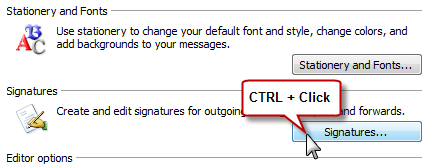
Or quickly open the folder by holding CTRL when clicking the Signatures… button.
If you want to backup just a single signature, look for the following files and folders;
.htm
This file is used when creating HTML messages..rtf
This file is used when creating Rich Text messages..txt
This file is used when creating Plain Text message._files
This folder is used in Outlook 2007, 2010 and 2013 to store supporting files for your signature such as formatting, images and/or business cards (vcf-files).
Tip!
With Windows Live Mesh (which is part of the Windows Live Essentials 2011 suite) you can sync Signatures across your computers so that your signatures will be the same on all your computers. This will also create a backup of your Signature on your SkyDrive account.
With Windows Live Mesh (which is part of the Windows Live Essentials 2011 suite) you can sync Signatures across your computers so that your signatures will be the same on all your computers. This will also create a backup of your Signature on your SkyDrive account.
Modifying the Plain Text signature
Once you’ve created a signature you might want to edit the signature to make it look better in Plain Text formatted mail.Plain Text, as the name suggests, does not support any type of formatting and thus your signature might look quite different from your HTML version. Common reasons for why you want to edit just your Plain Text signature afterwards are;
- Your signature contains an image with relevant information.
As the image is not displayed, this information is missing. Examples are having a business card picture or a company logo inserted instead of a company name in text. - Special text formatting
If you used Wingdings or tables, your text could be display wrong. By modifying the Plain Text signature manually, you can replace those characters and fix the aligning. - Hyperlinks
If you’ve got linked words such as for instance to a website, then in the Plain Text version of your signature only the text remains and the links are gone. Editing the Plain Text signature will allow you to add back the URL in full.
Adding variables, random quotes and more
If you want to go beyond the feature that Outlook has to offer for signatures, there are various add-ins available.Random Quote Insert
Add a famous quote to the end of your emails with the Random Quote Insert add-in. It comes packed with already 500 quotes to choose from and you can easily add your own as well.Discount code: BH93RF24
Live Signatures
With Live Signatures you can use variable in your signature which will be filled automatically when you insert your signature. This will allow you to insert up-to-date last minute information when sending out your message. Common uses for this is to include content which is updated by somebody else or from an RSS feed (latest headline from your company for instance).Discount code: 4PM76A8
Bells & Whistles for Outlook
Amongst many other features that Bells & Whistles for Outlook has to offer it will let you create multiple rich text or HTML email signatures and have them automatically inserted into your emails. Using the rules options, you can setup different signatures for different email accounts or contacts.Creating signatures in OWA
If you are working in a corporate environment and also have access to your Exchange mailbox via Outlook Web Access (OWA), then you’ll notice that your Outlook signatures are not available there. You’ll have to set these up again in OWA as well.You can find the Signature option in OWA in the following locations;
- OWA 2003
Options button in the left bottom corner-> section Messaging Options-> button Edit Signature… - OWA 2007
Options button in the top right corner-> section Messaging-> E-mail Signature - OWA 2010
Options button in the top right corner-> section Settings-> tab Mail
Adding images to OWA signatures
You’ll find the options available to you to be quite similar to the options that are available in Outlook. However, an option that you mind find missing is to add an image to your signature. Via a workaround, it is still possible to add this in the following way;- Place the picture on a web location if it is not available on-line yet like for instance the company logo on the corporate website.
- Browse to this location on the web.
- Right click on the picture that you want to add and choose Copy.
- Right click in the signature in OWA and choose Paste.
- Click “No” when you get a security prompt about content coming from a non-HTTPS source.
- Don’t forget to save the signature by pressing the Save button in the Options screen.
Note:
If the picture does not show up and a text-based link is displayed instead, disable the S/MIME control in OWA via the Security section.
If the picture does not show up and a text-based link is displayed instead, disable the S/MIME control in OWA via the Security section.
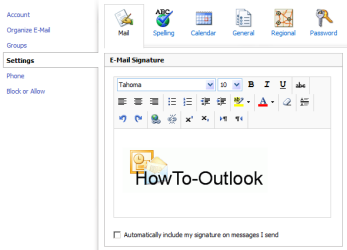
It’s possible to add a picture to a signature in OWA as well.
(click on image to enlarge)
Signatures in a corporate environment
When you are in a corporate environment and are responsible for proper signature usage in your corporation, then you might want to consider ways to centrally manage signature usage. This can be achieved in various ways such as via a script to generate personalized signatures on the client or mail server or a combination thereof.Such a client script and instructions how you can configure Exchange to automatically generate user signatures or append corporate disclaimers to outgoing messages can be found in the guide Setting up a Corporate Signature.
Disabling the signature option in Outlook
When you are centrally managing your user’s signatures, then disabling the Signature option would be recommended. This will prevent users from adding signatures of their own and ending up with messages with a double signature.Disabling the signature feature can be done via Group Policies. You’ll find back the option in;
Outlook Options-> Mail Format-> option: Do not allow signatures for e-mail messages
Note:
When you set this option, don’t forget to inform your users about it so that won’t be confused about the option being not available and to instruct them not to type in a signature manually into each message.
When you set this option, don’t forget to inform your users about it so that won’t be confused about the option being not available and to instruct them not to type in a signature manually into each message.
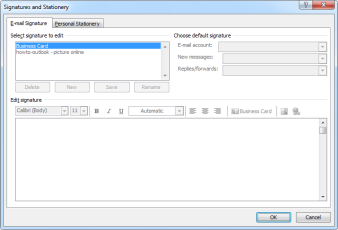
The signature section will appear grayed out after setting
this Group Policy setting. (click on image to enlarge)
Disclaimer text
If you need to add a disclaimer text and you are responsible for adding it; keep it short! There is nothing more annoying for the receiver to see a short message become massive just because of some disclaimer text.Consider posting the disclaimer text to a page on the corporate website and only add a link to it at the bottom of the message with “Please read our disclaimer” or something like that.
If you are automatically adding the signature via Exchange, you can configure it in such a way that the disclaimer is only added for external messages. For an example see Setting up a Corporate Signature.
No comments:
Post a Comment